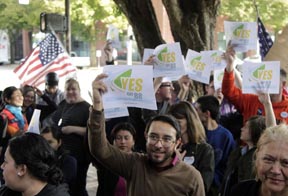
WASHINGTON: Immigrants entering the U.S. illegally are increasingly making states along the East Coast their home rather than states closer to the Mexican border.
New Jersey, Florida and Pennsylvania were among seven states to register gains in unauthorized immigrants from 2009 to 2012, even as the total number of immigrants here in the U.S. unlawfully was unchanged at 11.2 million, according to a report by the nonpartisan Pew Research Center.
New Jersey had the biggest gain, jumping 75,000 to 525,000 as many immigrants from India and Ecuador crossed illegally into the state.
It was followed by Florida, increasing 50,000 to 925,000. Pennsylvania was third, rising 30,000 to 170,000. It saw increases from several regions including Honduras, India and the Dominican Republic, many of whom moved into the rapidly diversifying southeastern part of the state.
Other states with increases were Maryland, Virginia, Idaho and Nebraska.
In the early to mid-2000s, migrants primarily from Mexico drove much of the nation’s illegal immigration into Western states. Now, 14 states including Arizona, California, Colorado, Nevada, New Mexico and Oregon are seeing declines.
Mexicans still make up the bulk of immigrants here illegally – roughly 52 percent, down from 56 percent in 2009 – but increasingly other countries, particularly from Central America, Asia and the Caribbean, are contributing to the mix.
The report comes as President Barack Obama seeks to move forward with executive actions that potentially could shield from deportation about 5 million immigrants here illegally. Congressional Republicans are in an uproar over the plans and are debating how to thwart the president.
Pew said it was too soon to say whether the shifting pattern of illegal immigration indicated a longer-term trend.
Illegal immigration peaked in 2007 at 12.2 million before the U.S. recession hit. Since then, fewer Mexicans have crossed into the U.S. while many here have chosen to return, due to a combination of factors including an improving Mexican economy, heightened U.S. attention on border enforcement and an aging Mexican workforce.
“We’ve seen a continued decline in the number of unauthorized immigrants from Mexico, which shows up in two key indicators: The number of new arrivals from Mexico has slowed, and at the same time, the number of Mexicans apprehended has reached a 40-year low,” said Jeffrey Passel, senior demographer at Pew.
The Pew analysis is based on census data. Because the Census Bureau does not ask people about their immigration status, the estimate on immigrants living in the U.S. illegally is derived largely by subtracting the estimated legal immigrant population from the total foreign-born population. It is a method that has been used by the government and Pew for many years and is generally accepted. -AP






